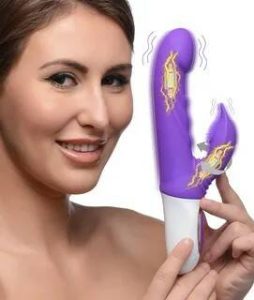Are vibrators very loud?
The noise level of vibrators can vary depending on various factors such as the specific model, the power source, and the materials used. However, most modern vibrators are designed with noise reduction in mind to provide a more discreet and enjoyable experience.
Battery-operated vibrators tend to be quieter compared to those powered by mains electricity. Additionally, vibrators made with high-quality materials such as silicone or ABS plastic tend to produce less noise. These materials help dampen the vibrations and minimize any mechanical sounds.
If noise level is a concern for you, you can look for vibrators that are labeled as “quiet” or “silent” in their product descriptions. Reading customer reviews and feedback can also give you an idea of the noise level of a particular vibrator.
It’s worth noting that while efforts are made to reduce noise, some vibrators may still produce a low hum or buzzing sound, particularly when used at higher vibration intensities. If discretion is important to you, you can consider using the vibrator under blankets or in a more secluded environment to further minimize any potential noise.
Remember that personal sensitivity to noise can vary, so what may be loud to one person might not be noticeable to another. If noise level is a significant concern for you, it may be helpful to test or research specific vibrator models known for their quiet operation or consider using other types of discreet sex toys such as small bullet vibrators or quieter manual toys like dildos.
What to look for when choosing a silent vibrator
When choosing a silent vibrator, there are several factors to consider to ensure a quieter and more discreet experience. Here are some key things to look for:
- Design and Materials: Opt for vibrators made with high-quality materials that help dampen sound, such as silicone or ABS plastic. These materials not only feel great on the skin but also minimize any mechanical noises that may be produced.
- Motor Technology: Look for vibrators that use advanced motor technology designed to reduce noise. Some manufacturers specifically advertise their vibrators as “whisper-quiet” or “silent” to indicate their noise-reduction features.
- Customer Reviews: Read customer reviews and feedback about the vibrator you’re considering. Look for comments specifically mentioning noise level to get an idea of how quiet or discreet the vibrator is in practice.
- Vibration Settings: Some vibrators offer multiple vibration settings or patterns. Choose a vibrator that allows you to adjust the intensity or has a variety of settings, as lower vibration settings often produce less noise.
- Battery-Powered or Rechargeable: Battery-powered vibrators tend to be quieter than those powered by mains electricity. Consider opting for a battery-powered vibrator or one that is rechargeable, as they often produce less noise.
It’s important to remember that everyone’s perception of noise may vary, so what one person finds quiet, another may consider loud. If possible, try to test or listen to the vibrator in person before purchasing. If that’s not feasible, carefully read the product descriptions, customer reviews, and manufacturer specifications to find a vibrator that aligns with your desire for a quieter experience.
Design and Materials
When choosing a silent vibrator, the design and materials used in its construction play a crucial role in minimizing noise. Here are some aspects to consider:
- Material Quality: Look for vibrators made from high-quality materials, such as medical-grade silicone or body-safe ABS plastic. These materials not only feel great on the skin but also help dampen any noise produced by the internal components.
- Seamless Construction: Opt for vibrators with a seamless or smooth construction. This helps prevent any gaps or loose parts that could cause rattling or additional noise during use.
- Soft or Flexible Materials: Vibrators made from softer or more flexible materials tend to produce less noise. They can absorb vibrations and reduce any mechanical sounds that may occur during operation.
- Solid Construction: Choose vibrators that have a solid and sturdy construction. A well-built vibrator is less likely to produce unnecessary noise or vibrations from loose or moving parts.
Motor Technology
When selecting a silent vibrator, the motor technology used in the device is an important consideration. Here are some aspects to look for:
- Whisper-Quiet Motors: Some manufacturers specifically design vibrators with whisper-quiet motors. Look for products that advertise their motors as quiet or silent, as these are designed to reduce noise during operation.
- Dual Motor Design: Vibrators with dual motors can offer more power and intensity while maintaining quieter operation. The motors work together to distribute vibrations evenly and minimize excessive noise.
- High-Quality Motors: Opt for vibrators with high-quality motors from reputable brands. These motors are often designed to run smoothly, efficiently, and with minimal noise.
- Variable Speed and Vibration Patterns: Vibrators that offer multiple speed settings and vibration patterns can be beneficial in terms of noise reduction. Lower speed settings generally produce less noise compared to higher ones.

Customer Reviews
Considering customer reviews is an essential aspect when choosing a silent vibrator. Reading reviews can provide valuable insights into the actual noise level and performance of the product. Here are some tips for using customer reviews effectively:
- Look for Specific Noise References: Pay attention to reviews that specifically https://incognito.black mention the noise level of the vibrator. Look for phrases like “whisper-quiet,” “silent,” or “discreet” to gauge whether the product meets your expectations in terms of noise reduction.
- Consider Multiple Reviews: Read a variety of customer reviews to get a balanced perspective. One person’s definition of quiet might differ from another’s, so it’s helpful to consider the overall consensus among reviewers.
- Check for Authenticity: When reading reviews, try to verify their authenticity. Look for detailed and descriptive reviews rather than generic or overly positive ones. Genuine reviews often include specific details about noise levels and personal experiences.
- Pay Attention to Verified Purchases: On platforms where purchases can be verified, prioritize reading reviews from customers who have actually purchased the product. Verified reviews carry more weight and credibility.
Vibration Settings
When selecting a silent vibrator, paying attention to the vibration settings can contribute to finding a model that suits your preferences for noise level. Here are some considerations regarding vibration settings:
- Adjustable Intensity: Look for vibrators that offer adjustable intensity levels. Having the ability to control the vibration strength allows you to find a setting that is comfortable and meets your desired noise level.
- Multiple Vibration Modes: Vibrators with various vibration patterns and modes can offer versatility in terms of noise level. Some patterns may produce less noise than others, so having options to choose from allows you to find the most suitable and quietest setting for your preferences.
- Low-Noise Settings: Some vibrators have specific low-noise or whisper-quiet settings designed to minimize noise while still providing pleasurable stimulation. These settings often offer a gentler and quieter vibration experience.
- Gradual Speed Increase: Consider vibrators that offer gradual speed increase options. This allows you to start with a lower vibration intensity and gradually increase it to find the sweet spot of stimulation without sudden changes that may create more noise.
Battery-Powered or Rechargeable
When choosing a silent vibrator, the power source is an important factor to consider. Here’s a comparison between battery-powered and rechargeable vibrators in terms of noise level:
Battery-Powered Vibrators:
- Noise Level: Battery-powered vibrators can produce varying levels of noise depending on the specific model and the quality of the motor. Some battery-powered vibrators may generate more noise due to the mechanics of the battery compartment.
- Vibrational Consistency: Battery-powered vibrators can experience a decrease in vibration intensity as the battery power drains. This inconsistency in vibration can impact the overall noise level and performance of the vibrator.
- Battery Compartment Noise: Vibrators with battery compartments may produce additional noise due to the movement or vibration of the batteries inside. This noise can be more noticeable if the batteries are not securely placed or if the vibrator is subject to strong movements.
Rechargeable Vibrators:
- Noise Level: Rechargeable vibrators often feature advanced motor technology designed to reduce noise during operation. They tend to be quieter compared to battery-powered vibrators due to their optimized motor design and power management systems.
- Consistent Vibration: Rechargeable vibrators offer consistent vibration intensity throughout the entire battery life. They maintain a steady performance without experiencing a decrease in power as the battery drains, ensuring a more reliable and consistent noise level.
- Seamless Design: Rechargeable vibrators often have a seamless design without a visible battery compartment, eliminating the potential noise from battery movement. This design feature contributes to a quieter overall experience.
Ultimately, both battery-powered and rechargeable vibrators can vary in noise level depending on their specific design and quality. If noise level is a significant concern, opting for a rechargeable vibrator with a reputation for being quiet and featuring advanced motor technology is generally a good choice. Reading product descriptions, customer reviews, and considering the reputation of the brand can provide valuable insights into the noise level of different vibrator models, regardless of their power source.





